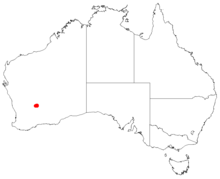Acacia adinophylla
| Acacia adinophylla | |
|---|---|
| Scientific classification | |
| Kingdom: | Plantae |
| Clade: | Tracheophytes |
| Clade: | Angiosperms |
| Clade: | Eudicots |
| Clade: | Rosids |
| Order: | Fabales |
| Family: | Fabaceae |
| Subfamily: | Caesalpinioideae |
| Clade: | Mimosoid clade |
| Genus: | Acacia |
| Species: | A. adinophylla
|
| Binomial name | |
| Acacia adinophylla | |

| |
| Occurrence data from AVH | |
Acacia adinophylla is a species of flowering plant in the family Fabaceae and is endemic to a small area in the south-west of Western Australia. It is a prostrate to erect, scrambling shrub with cylindrical branchlets, narrowly wedge-shaped to lance-shaped phyllodes, flowers arranged in up to 4 spherical heads of dull golden yellow flowers, and paper-like pods.
Description[edit]
Acacia adinophylla is a prostrate to erect, dense, scrambling shrub that typically grows up to 1.5 m (4 ft 11 in) high and 1.7 m (5 ft 7 in) wide and has cylindrical branchlets usually covered with soft hairs. Its phyllodes are crowded on side branches, narrowly wedge-shaped to lance-shaped with the narrower end towards the base, 3–7 mm (0.12–0.28 in) long and 1–2 mm (0.039–0.079 in) wide, thick and flat. There are triangular stipules 0.5–1.0 mm (0.020–0.039 in) long at the base of the phyllodes. The flowers are arranged in up to 4 spherical head 5–6 mm (0.20–0.24 in) in diameter, on a peduncle 6–15 mm (0.24–0.59 in) long. The heads contain 20 to 30 dull golden-yellow flowers. Flowering has been observed in June and from September to December, and the pod is firmly papery, narrowly oblong, up to 20 mm (0.79 in) long and 5–7 mm (0.20–0.28 in) wide, and scarcely constricted between the seeds. The seeds are spherical, about 3 mm (0.12 in) in diameter and dark brown with an large, cream aril curving half-way around the seed.[2][3][4]
Taxonomy[edit]
Acacia adinophylla was first formally described in 1999 by Bruce Maslin in the journal Nuytsia from specimens collected in the Helena and Aurora Range by Andrew Phillip Brown in 1984.[4][5] The specific epithet (adinophylla) means "crowded leaved".[4]
This species is included in the subgenus Phyllodineae.[6]
Distribution and habitat[edit]
This species is known from populations near the type location in the Coolgardie and Mallee bioregions of south-western Western Australia, where it grows in well-drained rocky soil in mallee shrubland with low scrub.[7]
Conservation status[edit]
Acacia adinophylla is classified as "Priority One" by the Government of Western Australia Department of Parks and Wildlife,[7] meaning that it is known from only one or a few locations which are potentially at risk.[8]
See also[edit]
References[edit]
- ^ "Acacia adinophylla". Australian Plant Census. Retrieved 6 May 2024.
- ^ Cowan, Richard S.; Kodela, Phillip G. "Acacia adinophylla". Flora of Australia. Australian Biological Resources Study, Department of Climate Change, Energy, the Environment and Water: Canberra. Retrieved 6 May 2024.
- ^ "Acacia adinophylla". World Wide Wattle. Western Australian Herbarium. Retrieved 6 May 2024.
- ^ a b c Maslin, Bruce R. (1999). "Acacia miscellany 16. The taxonomy of fifty-five species of Acacia, primarily Western Australian, in section Phyllodineae (Leguminosae: Mimosoideae)". Nuytsia. 12 (3): 318–320. Retrieved 6 May 2024.
- ^ "Acacia adinophylla". APNI. Retrieved 6 May 2024.
- ^ "Acacia adinophylla". World Wide Wattle. Retrieved 6 May 2024.
- ^ a b "Acacia adinophylla". FloraBase. Western Australian Government Department of Biodiversity, Conservation and Attractions.
- ^ "Conservation codes for Western Australian Flora and Fauna" (PDF). Government of Western Australia Department of Parks and Wildlife. Retrieved 6 May 2024.

